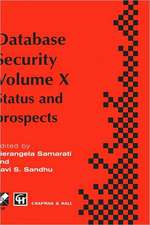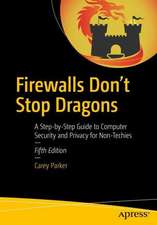Secure Cloud Computing
Editat de Sushil Jajodia, Krishna Kant, Pierangela Samarati, Anoop Singhal, Vipin Swarup, Cliff Wangen Limba Engleză Hardback – 24 ian 2014
| Toate formatele și edițiile | Preț | Express |
|---|---|---|
| Paperback (1) | 640.99 lei 38-44 zile | |
| Springer – 27 aug 2016 | 640.99 lei 38-44 zile | |
| Hardback (1) | 656.51 lei 6-8 săpt. | |
| Springer – 24 ian 2014 | 656.51 lei 6-8 săpt. |
Preț: 656.51 lei
Preț vechi: 820.64 lei
-20% Nou
Puncte Express: 985
Preț estimativ în valută:
125.64€ • 130.68$ • 103.72£
125.64€ • 130.68$ • 103.72£
Carte tipărită la comandă
Livrare economică 14-28 aprilie
Preluare comenzi: 021 569.72.76
Specificații
ISBN-13: 9781461492771
ISBN-10: 1461492777
Pagini: 343
Ilustrații: XII, 343 p. 95 illus.
Dimensiuni: 155 x 235 x 25 mm
Greutate: 0.72 kg
Ediția:2014
Editura: Springer
Colecția Springer
Locul publicării:New York, NY, United States
ISBN-10: 1461492777
Pagini: 343
Ilustrații: XII, 343 p. 95 illus.
Dimensiuni: 155 x 235 x 25 mm
Greutate: 0.72 kg
Ediția:2014
Editura: Springer
Colecția Springer
Locul publicării:New York, NY, United States
Public țintă
Professional/practitionerCuprins
Cryptographic Key Management Issues and Challenges in Cloud Services.- Costs and Security in Clouds.- Hardware-enhanced Security for Cloud Computing.- Cloud Computing Security: What Changes with Software-Defined Networking?.- Proof of Isolation for Cloud Storage.- Selective and Fine-Grained Access to Data in the Cloud.- Enabling Collaborative Data Authorization Between Enterprise Clouds.- Making Query Execution Over Encrypted Data Practical.- Privacy-preserving Keyword Search over Encrypted Data in Cloud Computing.- Towards Data Confidentiality and a Vulnerability Analysis Framework for Cloud Computing.- Secure Mission-Centric Operations in Cloud Computing.- Computational Decoys for Cloud Security.- Towards Data Confidentiality and a Vulnerability Analysis Framework for Cloud Computing.- Software Cruising: A New Technology for Building Concurrent Software Monitor.- Controllability and Observability of Risk and Resilience in Cyber-Physical Cloud Systems.
Recenzii
From the book reviews:
“It provides practitioners as well as researchers with an impressive and fascinating state-of-the-art overview of cloud security techniques and approaches. The book is suitable and highly recommended for anyone from graduate students to researchers in the field. I sincerely hope that organizing recent results in cloud computing security in this manner will make these results accessible to a wide audience and prepare future generations of software and hardware developers for the challenges they will face.” (Burkhard Englert, Computing Reviews, September, 2014)
“It provides practitioners as well as researchers with an impressive and fascinating state-of-the-art overview of cloud security techniques and approaches. The book is suitable and highly recommended for anyone from graduate students to researchers in the field. I sincerely hope that organizing recent results in cloud computing security in this manner will make these results accessible to a wide audience and prepare future generations of software and hardware developers for the challenges they will face.” (Burkhard Englert, Computing Reviews, September, 2014)
Caracteristici
Provides state-of-the-art coverage of techniques to address security and privacy challenges at all levels ranging from hardware mechanisms to application level techniques Topics include practical considerations of cloud computing security, as well as security issues related to the cloud infrastructure, data protection, computation deployment, and security state monitoring Useful for researchers, practitioners, and students to further research the subject and the implementation of the techniques in real-life systems Includes supplementary material: sn.pub/extras



























